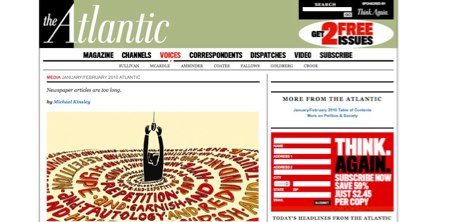Newspaper Style
Stacey Mason

Michael Kinsley offers one reason why newspapers are dying which has nothing to do with cost, technology, or distribution: the wordy conventions of newspaper articles. Kinsley notes that newspaper conventions dictate that the article give “context” and “backstory” whereas Web articles get right to the point. Thus paper articles often give more context than content.
Take, for example, the lead story in The New York Times on Sunday, November 8, 2009, headlined “Sweeping Health Care Plan Passes House.” […]The 1,456-word report begins:
“Handing President Obama a hard-fought victory, the House narrowly approved a sweeping overhaul of the nation’s health care system on Saturday night, advancing legislation that Democrats said could stand as their defining social policy achievement.”
Fewer than half the words in this opening sentence are devoted to saying what happened. If someone saw you reading the paper and asked, “So what’s going on?,” you would not likely begin by saying that President Obama had won a hard-fought victory. You would say, “The House passed health-care reform last night.” And maybe, “It was a close vote.” And just possibly, “There was a kerfuffle about abortion.” You would not likely refer to “a sweeping overhaul of the nation’s health care system,” as if your friend was unaware that health-care reform was going on.
While it’s certainly true that weblog posts tend to be more tightly-worded than newspaper articles, an important factor to remember is that weblogs can be more concise because they link. Rather than giving backstory, we can just link to it. We no longer need to spend several words introducing our source or proving that it’s credible; the reader can easily follow the source and determine its credibility for herself.
